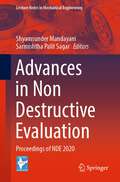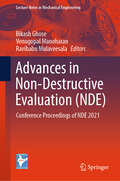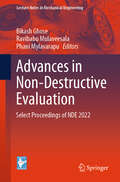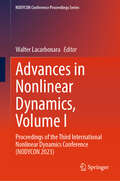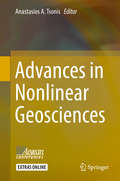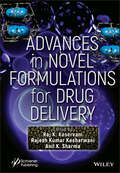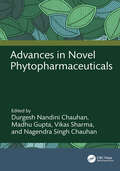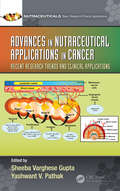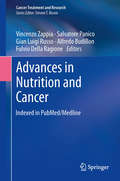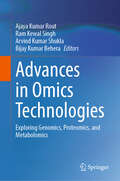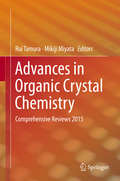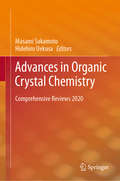- Table View
- List View
Advances in Non Destructive Evaluation: Proceedings of NDE 2020 (Lecture Notes in Mechanical Engineering)
by Shyamsunder Mandayam Sarmishtha Palit SagarThis book comprises the proceedings of the Conference and Exhibition on Non Destructive Evaluation (NDE 2020). The contents of the volume encompass a vast spectrum from Conventional to Advanced NDE including novel methods, instrumentation, sensors, procedures, and data analytics as applied to all industry segments for quality control, periodic maintenance, life estimation, structural integrity and related areas. This book will be a useful reference for students, researchers and practitioners.
Advances in Non-Destructive Evaluation: Conference Proceedings of NDE 2021 (Lecture Notes in Mechanical Engineering)
by Ravibabu Mulaveesala Bikash Ghose Venugopal ManoharanThis book comprises the proceedings of the Conference and Exhibition on Non-Destructive Evaluation (NDE 2021) organised by the Indian Society for Non-destructive Testing (ISNT). This book covers topics from wide domains from conventional to advanced NDE, including conventional and advanced NDE methods, drone-based inspections, thermal wave imaging, NDT data fusion, material characterization, waveguide sensors, inspections of civil structures, medical applications such as bone density and cancer diagnosis, periodic maintenance, life estimation, as well as structural integrity and related areas. This book serves as a useful reference for students, researchers, and practitioners alike.
Advances in Non-Destructive Evaluation: Select Proceedings of NDE 2022 (Lecture Notes in Mechanical Engineering)
by Ravibabu Mulaveesala Bikash Ghose Phani MylavarapuThis book comprises the proceedings of the Conference and Exhibition on Non-Destructive Evaluation (NDE 2022). The contents of the volume encompass a vast spectrum from conventional to advanced NDE including novel methods, and emerging NDE technologies. It covers topics from wide domains from conventional to advanced NDE methods which includes but not limited to drone-based inspections, thermal wave imaging, microwave NDE, shearography, Quantitative NDE using Digital Image Correlation, modeling and simulation, NDT data fusion, material characterization, waveguide sensors, inspections of civil structures, medical applications such as bone density and cancer diagnosis, signal and image processing, NDE sensors, instrumentation, software and systems, NDE 4.0 and robotics, automation, AI in NDE, functional and operational testing, NDE data analytics, reliability and safety assurance, periodic maintenance, life estimation, as well as structural integrity and related areas. This book serves as a useful reference for students, researchers, and practitioners working in the areas of non-destructive testing and evaluation.
Advances in Noninvasive Food Analysis (Contemporary Food Engineering)
by Muhammad Kashif Iqbal KhanTo ensure food quality and safety food, professionals need a knowledge of food composition and characteristics. The analysis of food product is required for quality management throughout the developmental process including the raw materials and ingredients, but food analysis adds processing cost for food industry and consumes time for government agencies. Advances in Noninvasive Food Analysis explores the potential and recent advances in non-invasive food analysis techniques used to ensure food quality and safety. Such cost-reducing and time-saving non-destructive food analysis techniques covered include, Infrared, Raman Spectroscopy, and Nuclear Magnetic Resonance. The book also covers data processing and modelling. Features: Covers the advent of non-invasive, non-destructive methods of food analysis Presents such techniques as near and mid infrared, Raman Spectroscopy, and Nuclear Magnetic Resonance Describes the growing role of nanotechnology in non-invasive food analysis Includes image analysis and data processing and modelling required to sort out the data The prime for this book are food professionals working in industry, control authorities and research organizations that ensure food quality and safety as well as libraries of universities with substantial food science programs, food companies and food producers with research and development departments. Also available in the Contemporary Food Engineering series: Advances in Food Bioproducts, Fermentation Engineering and Bioprocessing Technologies , edited by Monica Lizeth Chavez Gonzalez, Nagamani Balagurusamy, Christobal N. Aguilar (ISBN 9781138544222) Advances in Vinegar Production, edited by Argyro Bekatorou (ISBN 9780815365990) Innovative Technologies in Seafood Processing, edited by Yesim Ozogul (ISBN 9780815366447)
Advances in Nonlinear Dynamics and Control of Mechanical and Physical Systems: Selected Articles from CSNDD 2023; 15–17 May; Marrakesh, Morocco (Springer Proceedings in Physics #301)
by Mohamed BelhaqThis book highlights recent advances in nonlinear dynamics and control with applications in mechanics and physics. The book includes selected articles from the 5th Conference on Structural Nonlinear Dynamics and Diagnosis (CSNDD 2023) and presents recent theoretical, experimental and numerical findings covering various topics in nonlinear structural dynamics and diagnosis. The main topics includes multiple scales dynamics, energy harvesting, dynamics of MEMS, NEMS and AFM, systems with time delay, quasi-periodic oscillations and synchronization, stochastic dynamics, analytical and semi-analytical methods, time series analysis, control and analysis of switching systems, structural health monitoring, nonlinear vibrations of structures, nonsmouth dynamics, nonlinear phenomena in discrete and continuum systems, dynamic modeling and fault diagnosis, constrained multi-catenary systems, conservative chaotic system, hysteretic structures, and nonlinear PDEs and their dynamics.
Advances in Nonlinear Dynamics, Volume I: Proceedings of the Third International Nonlinear Dynamics Conference (NODYCON 2023) (NODYCON Conference Proceedings Series)
by Walter LacarbonaraThis volume aims to present the latest advancements in experimental, analytical, and numerical methodologies aimed at exploring the nonlinear dynamics of diverse systems across varying length and time scales. It delves into the following topics:Methodologies for nonlinear dynamic analysis (harmonic balance, asymptotic techniques, enhanced time integration)Data-driven dynamics, machine learning techniquesExploration of bifurcations and nonsmooth systemsNonlinear phenomena in mechanical systems and structuresExperimental dynamics, system identification, and monitoring techniquesFluid-structure interactionDynamics of multibody systemsTurning processes, rotating systems, and systems with time delays
Advances in Nonlinear Dynamics, Volume II: Proceedings of the Third International Nonlinear Dynamics Conference (NODYCON 2023) (NODYCON Conference Proceedings Series)
by Walter LacarbonaraThis second of three volumes presents papers from the third series of NODYCON to be held in June of 2023. The conference papers reflect a broad coverage of topics in nonlinear dynamics, both traditionally placed in established streams of research as well as they stand as newly explored and emerging venues of research. These include• Multi-scale dynamics: multiple time/space scales, large system dynamics• Experimental dynamics: benchmark experiments, experimental methods,instrumentation techniques, measurements in harsh environments, experimentalvalidation of nonlinear models• Reduced-order modeling: center manifold reduction, nonlinear normal modes, normalforms• Systems with time and/or space delays• Nonlinear interactions in multi-dof systems: parametric vibrations, multiple external andautoparametric resonances.• Computational techniques: efficient algorithms, use ofsymbolic manipulators, integrationof symbolic manipulation and numerical methods, use of parallel processors.• Nonlinear system identification: parametric/nonparametric identification, data-drivenidentification• Multibody dynamics: rigid and flexible multibody system dynamics, impact and contactmechanics, tire modeling, railroad vehicle dynamics, biomechanics applications,computational multibody dynamics• Fluid/structure interaction• Nonlinear wave propagation in discrete and continuous media
Advances in Nonlinear Dynamics, Volume III: Proceedings of the Third International Nonlinear Dynamics Conference (NODYCON 2023) (NODYCON Conference Proceedings Series)
by Walter LacarbonaraThis third of three volumes presents papers from the third series of NODYCON to be held in June of 2023. The conference papers reflect a broad coverage of topics in nonlinear dynamics, both traditionally placed in established streams of research as well as they stand as newly explored and emerging venues of research. These include• Multi-scale dynamics: multiple time/space scales, large system dynamics• Experimental dynamics: benchmark experiments, experimental methods,instrumentation techniques, measurements in harsh environments, experimentalvalidation of nonlinear models• Reduced-order modeling: center manifold reduction, nonlinear normal modes, normalforms• Systems with time and/or space delays• Nonlinear interactions in multi-dof systems: parametric vibrations, multiple external andautoparametric resonances.• Computational techniques: efficient algorithms, use ofsymbolic manipulators, integrationof symbolic manipulation and numerical methods, use of parallel processors.• Nonlinear system identification: parametric/nonparametric identification, data-drivenidentification• Multibody dynamics: rigid and flexible multibody system dynamics, impact and contactmechanics, tire modeling, railroad vehicle dynamics, biomechanics applications,computational multibody dynamics• Fluid/structure interaction• Nonlinear wave propagation in discrete and continuous media
Advances in Nonlinear Dynamos (The Fluid Mechanics of Astrophysics and Geophysics #1)
by Manuel Núñez Antonio Ferriz-MasNonlinear dynamo theory is central to understanding the magnetic structures of planets, stars and galaxies. In chapters contributed by some of the leading scientists in the field, this text explores some of the recent advances in the field. Both kinetic and dynamic approaches to the subject are considered, including fast dynamos, topological methods in dynamo theory, physics of the solar cycle and the fundamentals of mean field dynamo. Advances in Nonlinear Dynamos is ideal for graduate students and researchers in theoretical astrophysics and applied mathematics, particularly those interested in cosmic magnetism and related topics, such as turbulence, convection, and more general nonlinear physics.
Advances in Nonlinear Geosciences
by Anastasios A. TsonisAdvances in Nonlinear Geosciences is a set of contributions from the participants of "30 Years of Nonlinear Dynamics" held July 3-8, 2016 in Rhodes, Greece as part of the Aegean Conferences, as well as from several other experts in the field who could not attend the meeting. The volume brings together up-to-date research from the atmospheric sciences, hydrology, geology, and other areas of geosciences and presents the new advances made in the last 10 years. Topics include chaos synchronization, topological data analysis, new insights on fractals, multifractals and stochasticity, climate dynamics, extreme events, complexity, and causality, among other topics.
Advances in Novel Formulations for Drug Delivery
by Anil K. Sharma Raj K. Keservani Rajesh Kumar KesharwaniADVANCES in NOVEL FORMULATIONS for DRUG DELIVERY The 27 chapters describe novel strategies for drug/nutraceutical delivery and embrace the development of formulations with herbal ingredients, while also highlighting disease therapeutics. Drug delivery technology has witnessed many advancements purported to cater to the customized needs of its ultimate beneficiaries—the patients. Today, dosage forms are not confined to conventional tablets, capsules, or injectables, but have evolved to cover novel drug carriers such as particulates, vesicles, and many others. Nanotechnological advancements have played a major role in this paradigm shift in ways of delivering active pharmaceutical ingredients. A new dimension in the use of food as medicine has also gained prominence in recent years. A portmanteau of nutrition and pharmaceuticals is “nutraceuticals,” also known as functional foods and dietary supplements. The technologies which were earlier included in drug delivery have been attempted for the delivery of nutraceuticals as well. Herbal actives have received increased attention due to their low risk-to-benefit ratio. The field of drug delivery is quite dynamic in nature, as witnessed by its evolution from conventional dosage forms to nanotechnology-assisted drug products. A variety of formulations via different drug delivery routes have been developed to treat/cure/mitigate diseases or disorders. This book, comprising of 27 chapters, is a thorough compilation of information relevant to drug delivery systems with an emphasis on products based on nanotechnology. Audience Researchers, scientists, industry professionals, formulators and product developers, regulatory agencies in a variety of settings including novel drug delivery research laboratories, pharmaceutical, and pharmacy industries, biomedical sciences, food and nutraceuticals manufacturers, and nanotechnology.
Advances in Novel Phytopharmaceuticals
by Madhu Gupta Durgesh Nandini Chauhan Vikas Sharma Nagendra Singh ChauhanAdvances in Novel Phytopharmaceuticals covers the current aspects of the development of novel herbal formulations and summarizes their type of active components, biological activity, applications, and toxicity associated with novel herbal formulations. Such distinct types of novel herbal formulations are described to have remarkable advantages over conventional formulations of plant actives and extracts. The book also covers the various herbal phytoconstituents used for novel drug delivery applications. These novel herbal formulations can be used more uprightly and with enhanced efficacy by incorporating them into modern dosage forms. This can be accomplished by designing novel drug delivery systems for herbal ingredients. This book provides key information for everyone interested in novel phytodrug delivery systems and drug discovery, including medicinal chemists, cosmetic experts, nutritionists, toxicologists, drug formulators, and healthcare professionals. Students, professors, and researchers working in pharmaceutical sciences and beyond will also find the book useful.We will also focus on patent filed, technology transfer, market potential, and regulatory aspects of herbal nanomedicines, if any. Research in this area is still in the exploratory stage, and in the market there are no books available that summarize all the contents of the research. As such, we will try to make our full contribution to this area. This book is the continuation of a first volume and readers and the target audience will gain all the latest knowledge in the subject.Aims and scopeð To understand the basic information and application of phytoconstituentsð To understand the various phytoconstituents-based formulations for disease managementð To understand the herbal drugs used for cosmetic applicationsð To understand the phytodrug delivery systems and their applicationsð To provide detailed knowledge about the technical aspects of formulationð To update readers with the latest research progress in this emerging research areað To provide the details about the patents filed, technology transfer, market potential, and regulatory aspects for the same
Advances in Nuclear Architecture
by Niall M. Adams Paul S. FreemontThis book provides a snapshot of the state-of-the art in the study of mammalian cell nuclear architecture, and features a diverse range of chapters written by top researchers. A key aspect is an emphasis on precise and repeatable quantitative analysis and simulation in addition to the more familiar biological perspective. The fusion of such material frames the future of the discipline. Quantitative contributions stress reproducible and robust 3D analysis, using a variety of tools ranging from point pattern analysis to shape registration methods. Biological insights include the role of nuclear subdomains in cancer, nuclear molecular motors, and a holistic view of gene transcription.
Advances in Nuclear Physics: Structure and Reactions (Springer Proceedings in Physics #257)
by Rohit Kumar Rajeev K. Puri Joerg Aichelin Sakshi GautamThis volume comprises select peer-reviewed papers from the Indo-French Workshop on Multifragmentation, Collective Flow, and Sub-Threshold Particle Production in Heavy-Ion Reactions held at the Department of Physics, Panjab University, Chandigarh, India in February, 2019. The contents highlight latest research trends in intermediate energy nuclear physics and emphasize on the various reaction mechanisms which take place in heavy-ion collisions. The chapters contribute to the understanding of interactions that govern the dynamics at sub-nucleonic level. The book includes contributions from global experts hailing from major research facilities of nuclear physics, and provides a good balance between experimental and theoretical model based studies. Given the range of topics covered, this book can be a useful reference for students and researchers interested in the field of heavy-ion reactions.
Advances in Numerical Heat Transfer, Volume 2: Advances In Numerical Heat Transfer Volume V (Computational And Physical Processes In Mechanics And Thermal Sciences Ser.)
by W. MinkowyczThis volume discusses the advances in numerical heat transfer modeling by applying high-performance computing resources, striking a balance between generic fundamentals, specific fundamentals, generic applications, and specific applications.
Advances in Numerical Heat Transfer, Volume 3 (Computational & Physical Processes in Mechanics & Thermal Scienc)
by W. J. MinkowyczDefinitive Treatment of the Numerical Simulation of Bioheat Transfer and Fluid FlowMotivated by the upwelling of current interest in subjects critical to human health, Advances in Numerical Heat Transfer, Volume 3 presents the latest information on bioheat and biofluid flow. Like its predecessors, this volume assembles a team of renowned internatio
Advances in Nutraceutical Applications in Cancer: Recent Research Trends and Clinical Applications (Nutraceuticals)
by Yashwant V. Pathak Sheeba Varghese GuptaDietary supplements and nutraceuticals such as Vitamin A and D, Omega-3 and probiotics are used as part of the cancer treatment as complimenting the main therapy. Several Nutraceuticals have shown to boost the immune responses, while emerging clinical studies and other research suggests that some plant-based agents may, indeed, impact late-stage cancer, influencing molecular processes corrupted by tumor cells to evade detection, expand clonally, and invade surrounding tissues. Advances in Nutraceutical Applications in Cancer: Recent Research Trends and Clinical Applications is an attempt to collect evidence and related clinical information of application of Nutraceuticals to be used in cancer treatment or compliment the cancer treatment. It contains 16 chapters written by experts in related field’s and covers many different aspects of the formulation and development of Nutraceuticals for cancer applications. This book covers efficacy, safety and toxicological aspects of nutraceuticals. It also addresses various novel drug delivery systems of nutraceuticals with anticancer properties, as well as nutraceuticals as supplements for cancer prevention. Features: Offers a comprehensive view of neutraceuticals’ role in cancer prevention and treatment Covers the applications and implications of neutraceuticals in prostate, colorectal, breast and gynecological cancers Discusses the principles of neutrigenomics and neutrigenetics in cancer prevention Explors the role of probiotics and micronutrients in cancer treatment and prevention Nutraceuticals can alter the gut microbiota. Gut microbiome undergoes changes during the disease status and followed by the cancer treatment. Nutraceutical’s role in proliferation and prevention of gynecological cancers, nutraceutical’s role in proliferation and prevention of prostate cancer and role of micronutrients in cancer prevention, both pros and cons, are some of the topics discussed in various chapters in this book. This book is addressed to scientists, clinicians, and students who are working in the area of Nutraceutical applications in cancer treatment.
Advances in Nutrition and Cancer (Cancer Treatment and Research #159)
by Vincenzo Zappia Salvatore Panico Gian Luigi Russo Alfredo Budillon Fulvio Della RagioneThis book comprises proceedings from the Third International Conference on Advances in Nutrition and Cancer, held in Naples in May 2012. This highly multidisciplinary meeting analyzed "nutrition and cancer" from different perspectives and on the basis of distinct and up-to-date experimental approaches. Knowledge on the relation between lifestyle, diet, and cancer is explored in a number of contributions, and the role of dietary intervention in cancer patients is discussed. Issues of vital interest to the research community, such as epidemiological and experimental oncology (genetics, epigenetics, and the mechanisms of action of natural compounds in the diet), receive detailed consideration. A further key topic is the emerging molecular technologies (the "omics") that can cast light on the interplay between nutrition and human malignancies. Chapters take the form of reviews that include sections presenting expert opinions.
Advances in Omics Technologies: Exploring Genomics, Proteomics, and Metabolomics
by Bijay Kumar Behera Ajaya Kumar Rout Ram Kewal Singh Arvind Kumar ShuklaThis comprehensive volume offers an in-depth exploration of the latest advancements in omics technologies and their practical applications across environmental science, agriculture, healthcare, and biotechnology. Covering key topics such as metagenomics for identifying beneficial microbes, bioremediation for environmental cleanup, bacteriophages, proteomics, epigenomics, and CRISPR-Cas9 genome editing, the book provides valuable insights into cutting-edge tools and methodologies. It also delves into next-generation sequencing, biosensor technology, bioinformatics tools, mass spectrometry-based metabolomics, as well as emerging fields like nutrigenomics and microarrays technology. With clear explanations and practical perspectives, this authoritative resource is ideal for students, researchers, and professionals striving to stay abreast of innovations in life sciences and contribute to the rapidly evolving landscape of omics sciences.
Advances in One-Dimensional Wave Mechanics: Towards A Unified Classical View
by Zhuangqi Cao Cheng YinAdvances in One-Dimensional Wave Mechanics provides a comprehensive description of the motion of microscopic particles in one-dimensional, arbitrary-shaped potentials based on the analogy between Quantum Mechanics and Electromagnetism. Utilizing a deeper understanding of the wave nature of matter, this book introduces the concept of the scattered sub-waves and a series of new analytical results using the Analytical Transfer Matrix (ATM) method. This work will be useful for graduate students majoring in physics, mainly in basic quantum theory, as well as for academic researchers exploring electromagnetism, particle physics, and wave mechanics and for experts in the field of optical waveguide and integrated optics. Prof. Zhuangqi Cao is a Professor of Physics at Shanghai Jiao Tong University, China. Dr. Cheng Yin is a teacher at Jiangsu Key Laboratory of Power Transmission and Distribution Equipment Technology, Hohai University, China.
Advances in Open Systems and Fundamental Tests of Quantum Mechanics: Proceedings of the 684. WE-Heraeus-Seminar, Bad Honnef, Germany, 2–5 December 2018 (Springer Proceedings in Physics #237)
by Bassano Vacchini Heinz-Peter Breuer Angelo BassiQuantum mechanics has shown unprecedented success as a physical theory, but it has forced a new view on the description of physical reality. In recent years, important progress has been achieved both in the theory of open quantum systems and in the experimental realization and control of such systems. A great deal of the new results is concerned with the characterization and quantification of quantum memory effects. From this perspective, the 684. WE-Heraeus-Seminar has brought together scientists from different communities, both theoretical and experimental, sharing expertise on open quantum systems, as well as the commitment to the understanding of quantum mechanics. This book consists of many contributions addressing the diversified physics community interested in foundations of quantum mechanics and its applications and it reports about recent results in open quantum systems and their connection with the most advanced experiments testing quantum mechanics.
Advances in Optical Imaging for Clinical Medicine (Wiley Series in Biomedical Engineering and Multi-Disciplinary Integrated Systems #6)
by Nicusor Iftimia William R. Brugge Daniel X. HammerThis book provides students, teachers, researchers and clinicians with a strong and established source of information on advanced optical technologies that show real promise of being translated to clinical use.
Advances in Orchid Biology, Biotechnology and Omics
by Jen-Tsung Chen Pragya TiwariThis book provides comprehensive insights into the existing and emerging trends in orchid biology based on the findings of omics, high-throughput technology, biotechnology, molecular breeding, and genome editing approaches in orchids. It illustrates molecular mechanisms of orchid mycorrhizal symbiosis according to the recent achievements of transcriptomics and bioinformatics studies which accelerate the progress of orchid research with the aid of their high-throughput tools. In this book, a comprehensive view of orchid breeding was presented, and it includes fundamental methods as well as advanced strategies through the combination of several technologies such as genetic engineering, omics, computational biology, and genome editing. These resulting knowledge and tools are highly beneficial for obtaining novel and fascinating varieties in the orchid market which is a competitive industry of global trade. Another interesting content is the focus on the production of orchid bioactive compounds and their values in the field of ethnomedicine. Their sources chiefly came from secondary metabolites and can be enriched through elicitors and produced more efficiently by improved tissue culture protocols and bioreactors. In this edited collection, we provided space for presenting an updated review of in vitro seed germination which is a routine technology for well-trained researchers but can give a complete demonstration for the potential audiences including growers and research beginners. This book collects refined knowledge from a broad source of scientific literature by experts in the field of orchid research and surely is an adequate reference and textbook for students, teachers, and researchers. It includes methods and applications of orchid breeding technology which would gain high attention from growers, breeders, and the related fields of agriculture.
Advances in Organic Crystal Chemistry: Comprehensive Reviews 2015
by Rui Tamura Mikiji MiyataFor the last decade, the topics of organic crystal chemistry have become diversified, and each topic has been substantially advanced in concert with the rapid development of various analytical and measurement techniques for solid-state organic materials. The aim of this book is to systematically summarize and record the recent notable advances in various topics of organic crystal chemistry involving liquid crystals and organic-inorganic hybrid materials that have been achieved mainly in the last 5 years or so. The authors are invited members of the Division of Organic Crystals, The Chemical Society of Japan (CSJ), and prominent invited experts from abroad. This edited volume is planned to be published periodically, at least every 5 years, with contributions by prominent authors in Japan and from abroad.
Advances in Organic Crystal Chemistry: Comprehensive Reviews 2020
by Masami Sakamoto Hidehiro UekusaThis book summarizes and records the recent notable advances in diverse topics in organic crystal chemistry, which has made substantial progress along with the rapid development of a variety of analysis and measurement techniques for solid organic materials. This review book is one of the volumes that are published periodically on this theme. The previous volume, published in 2015, systematically summarized the remarkable progress in assorted topics of organic crystal chemistry using organic solids and organic–inorganic hybrid materials during the previous 5 years, and it has been widely read. The present volume also shows the progress of organic solid chemistry in the last 5 years, with contributions mainly by invited members of the Division of Organic Crystal Chemistry of the Chemical Society of Japan (CSJ), together with prominent invited authors from countries other than Japan.
